 |
 |
 |
 |
||||||||||||||
 |
 |
 |
 |
 |
|||||||||||||
| Topics |
- Course overview
- Genomic Art - overview
- Interactive arts: Media Arts Video segment, Design|Media Arts, http://rhizome.org/fresh/
- The Gene Hunters: Video: http://www.pbs.org/saf/1202/video/watchonline.htm
- Genetics:
The basics about DNA and the genetic code.
- HGP Info Center: http://www.ornl.gov/hgmis/project/info.html
- Genetics Science Learning Center: http://gslc.genetics.utah.edu/basic/,
- Dolan DNA Learning Center,CSH: http://vector.cshl.org/dnaftb/
- Sampling of online resources for artists and genetics. (Resources)
- What?
- Geneome Education: http://www.nhgri.nih.gov/educationkit/
| Reading/Surfing | Assignment | |
|
View: Assignments |
|
| Course Description |
 |
 |
 |
 |
 |
 |
 |
 |
|||||
| Genomic Art |
"All artists are trying to literally create life." William Burroughs [4]
 |
Before the concepts of DNA, heredity and evolution, humanity believed that the origin of life was divine. We used constructs such as preformation, epigenesis, the vital force of spontaneous generation and the Homunculus to explain our origin and the creation of all living things. Fast forward to 1997 and we've "created" Dolly. Jump forward again to December 25, 2001 and we've heralded the birth of five cloned and genetically modified piglets: Noel, Angel, Star, Joy and Mary.[5] Their genetic alteration our hope for renewal through xenotransplantation: cross species organ transplants. [2] Today, you can have a faulty heart valve replaced by one that is a porcine xenograft ,[7] but what happens when you need more? The piglets are part of the hope for greater acceptance by our bodies of organs from other species. [8] With the advent of cloning and the many other genetic/biotechnological advances of recent years, a dialog has developed about the implications for us as a species. As the benefits are extolled, many are asking "Are we culturally, ethically, psychologically and emotionally ready for what the "promise" of biotechnology has in store for us?" There are many more questions. Where will our answers come from? Where does the dialog about them exist? Who are the participants? Where do we each fit? |
|
 |
Our exploration of genomic art will touch upon the many ways that artists are a vital part of the current dialog surrounding these advances and issues. Artists often facilitate and contribute to this dialog by processes which constitute an intersection of art and science. It is from this vantage point that the core questions for this course arose. Are artists adding something to our understanding of life that scientists are not or simply cannot? Do these interdisciplinary efforts give us keys to achieving the leading edge in any field? Is it possible that in this intersection of art and science, in the process of interdisciplinary work, lie keys to how we may find the answers which we seek, and other benefits as well? | |
 |
This course is offered within the Design|Media Arts department. You may wonder about this. Yet Genomic Art exists within many contexts, one of them being the intersection of art and technology. Many of the artists creating "genetic art" work within the realm of interactive or media art. This is not a coincidence. The applied intersection of art and technology is an essential aspect of media art. In this case, the technology also includes DNA and living organisms as one of many media used by artists. Part of our exploration will include learning the vocabulary of visual culture, and that of interactive and media arts. We will accomplish this through our readings, "surfing," discussions and by exploring the work of media artists, including those who are part of our UCLA Design|Media Arts faculty. | |
| The Gamut |
Artists' contribution to the dialog run a wide gamut, and while addressing events in the sphere of biotechnology, they create novel approaches to art making. Here are some examples of genomic art works that span the gamut we will be encountering. Genomic artworks extend from 2D images to living organisms that you interact with through mediating systems, to virtual environments and organisms created by the techniques of artificial life.
| Let's enter the dialog by juxtaposing a painting and recent news about the cloned piglets. |
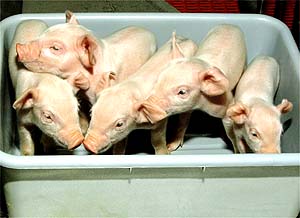 |
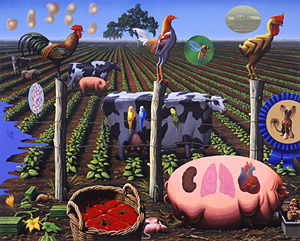 |
|||||
| Five cloned piglets: Noel, Angel, Star, Joy and Mary | The Farm, 2000 | |||||
| Born
on Christmas Day 2001 in the US Scottish-based firm PPL Therapeutics |
oil
and acrylic on wood panel, 96 x 120 in. Courtesy of JGS, Inc. |
|||||
In this work Alexis Rockman juxtaposes images of domestic animals, cows, chickens, mice, pigs and vegetables, and their genetically modified counterparts. The team that gave us Dolly, recently gave us the five cloned piglets genetically modified so that there is less likelihood that their organs would be rejected by human bodies upon transplantation. Alexis Rockman has imagined one step further: genetically modified pigs that are the "medium" used to clone and culture human organs for transplantation.
We may look at this and think/feel any number of things ranging from fascination to fear. We may even feel that reality has far outstripped the ability of any kind of art to "shock" us in to deeper understandings. Yet the painting serves to remind us that our relationship to nature has never been neutral. There are crops and domesticated animals in the image. We may feel more at ease with their images out of familiarity, yet we must not forget that they too are the product of our long standing practices of genetic modification by selective breeding.
| Let's look at another set of images. Which is scientific and which artistic in origin? |
 |
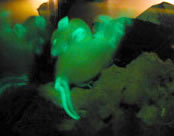 |
 |
|||
| Biobot, Eighth Day, E. Kac, 2001 | GFP Mice, Eighth Day, E. Kac,2001 | Folsomia candida (Collembola) | |||
| "A biobot is a robot with an active biological element within its body which is responsible for aspects of its behavior. [It ]has a colony of GFP amoeba called Dyctiostelium discoideum as its "brain cells". These "brain cells" form a network within a bioreactor that constitutes the "brain structure" of the biobot. When amoeba divide the biobot exhibits dynamic behavior inside the enclosed environment." Greater amoebal activity causes ascending motion, lesser descending motion. Web participants can control the movement of the pan acutator of the biobot visual system.[16] | "The Eighth Day presents an expansion of biodiversity beyond wildtype life forms. As a self-contained artificial ecological system it resonates with the words in the title, which add one day to the period of creation of the world as narrated in the Judeo-Christian Scriptures. All of the transgenic creatures in The Eighth Day are created through the cloning of a gene that codes for the production of green fluorescent protein (GFP). As a result, all creatures express the gene through bioluminescence visible with the naked eye. The transgenic creatures include GFP tobacco, dictyostelium, fish, and mice."[16] |
Fed with gfp-tagged Escherichia coli. (Epifluorescence microscopy image, contributed by Christoph Tebbe.) "Use of GFP to tag bacteria and monitor bacterial survival. An approach for monitoring GMMs (GMMs) (e.g. biofertilisers and biopesticides) in nature and their biosafety aspects. Genetically modified microorganisms (Specific genes can be used as markers for monitoring of bacterial survival or as reporters for monitoring gene expression."[17] |
|||
The Eighth Day is a transgenic artwork developed collaboratively by Eduardo Kac and a team of biologists. It consists of a self-contained ecology of GFP organisms. A terrarium representing our newly enhanced ability to manipulate nature through molecular genetics. This work is an example of many different aspects of Genomic and Media Arts. As a media art work it uses technology to allow web participants to affect the system and again to mediate the experience for onsite (gallery) viewers, and utilizes genetics/living organisms as a medium to communicate it's message.
By enabling local and online participants to experience the environment inside the dome from the point of view of the biobot, The Eighth Day creates a context in which participants can reflect on the meaning of a transgenic ecology from a first-person perspective.[16]
"We feel that artistic endeavors such as The Eighth Day project have the potential to reach a far broader audience than the scientific press. By communicating with a wider audience than those who already vocally support or oppose the development of transgenic animals, we hope to positively advance the debate on the use of transgenic technology in our society."
Alan
Rawls and Jeanne Wilson-Rawls
Biologists
"The Eighth Day is a transgenic artwork that investigates the new ecology of fluorescent creatures that is evolving worldwide."
Eduardo
Kac
Artist
| Green, Reinhard Nestelbacher | ||
|
"Harbingers of a new dimension of design and the aftermath of transgressed boundaries. A new “species” of artificial organisms and creatures has come about as what amounts to a by-product of molecular biological research: green-glowing mice, fish, plants and bacteria. Green takes what is an everyday scientific phenomenon in the form of a cautiously compiled exhibit and exports it beyond the confines of the lab; this alone makes it seem to be something between unusual and bizarre. The project presents a number of organisms as examples of genetic modification with GFP — unusual messengers from the world of science. Organisms as image-generating ‘apparatuses.’ The aim of Green is not only to point out the use of living creatures as image-generating apparatuses, but also to shake things up with respect to the world of science and its images. The diametrical juxtaposition of the world of scientists and that of laypersons shows just how large the gap is, how far removed scientific research has become, and how essential it is now to finally begin closing this gap. " [15] |
||
| On the other end of the spectrum, there's work in digital evolution. |
Tierra uses evolution by natural selection in the medium of the digital computer to generate complex and intelligent software.[19]
Evolutionary race between hosts and parasites in a soup of the Tierra Synthetic Life program.
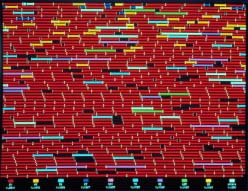 |
Hosts, red, are very common. Parasites, yellow, have appeared but are still rare. | 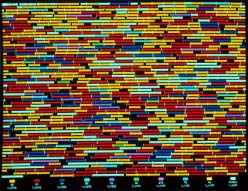 |
Hosts, are now rare because parasites have become very common. Immune hosts, blue, have appeared but are rare. | ||
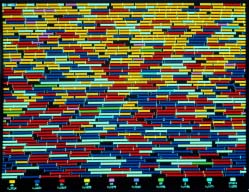 |
Immune hosts are increasing in frequency, separating the parasites into the top of memory. | 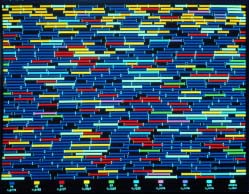 |
Immune hosts now dominate memory, while parasites and susceptible hosts decline in frequency. The parasites will soon be driven to extinction. | ||
- Evolution by natural selection has generated complex and intelligent life forms in the medium of carbon chemistry.
- Evolution is the only process with a proven ability to produce intelligence.
- The DNA of living organisms is a genetic ``program''. This is a parallel software of a complexity much greater than any that could be written by humans.
- Experiments illustrated here show that evolution by natural selection works very effectively in the medium of computer machine code.
- Evolution will find forms and processes that exploit the possibilities inherent in the computational medium.
- Self-replicating machine code programs are introduced to the RAM memory of the computer.
- Genetic variation occurs due to ``mutations'' resulting from random flips (between 0 and 1) of bits in the memory.
- A ``reaper'' function of the operating system kills old or defective processes in order to make way for newborn programs, once the memory is full.
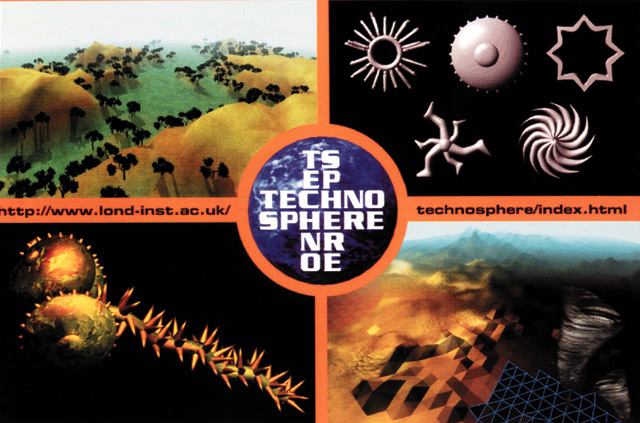
http://www.v2.nl/DEAF/web/web.html
"TechnoSphere (UK) is a virtual 3D world which is accesible through the Internet. It offers the possibility of creating a artificial lifeforms by freely combining a number 'body parts' that are offered on the site. This beastie is then placed in a virtual landscape environment. The artificial lifeforms grow and develop in a short time and send messages and animations to their creators via e-mail. TechnoSphere is an arena where digital lifeforms try to find a future. Artificial lifeforms vie for food and develop their own genetic code to survive. The evolutionary development of this 3D world is dependent on the participation of an on-line audience.
http://www.lond-inst.ac.uk/TechnoSphere/index.html "
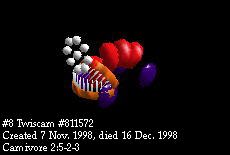 |
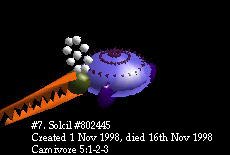 |
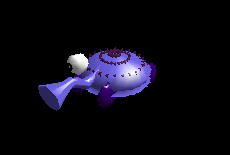 |
||||
|
Twiscarn
811572
|
Solcil
802445
|
Scylunk
839303
|
||||
"A page showing the creatures I've created in the Technosphere biosphere simulation, with links to the information about them, and links to other people's webpages about their creatures."
http://www.table76.demon.co.uk/Technosphere/technosphere.html
Carnivore 5:5-2-3
Attributes Family tree Map
------------------------------------------------------------------------
Bore two children:
TwiscilI 896311 [Attributes Family tree Map]
TwiscilI 908497 [Attributes Family tree Map]
------------------------------------------------------------------------
Sired three children:
SylphII 878345 (Dead) Family tree
StalinI 910426 [Attributes Family tree Map]
ViirupyllyI 912317 [Attributes Family tree Map]
| Questions |
Art
Definition: Human effort to imitate, supplement, alter, or counteract the work of nature.
The
American Heritage® Dictionary of the English Language, Fourth Edition
Copyright © 2000 by Houghton Mifflin Company.
Some questions:
- Is this science or is this art?
- What contribution to science, or our knowledge about life is this work making?
- How is this art different from "traditional" definitions of art you have encountered before?
- How is genetic alteration of living organisms the same or different form art?
- More questions...
As we explore Genomic Art, we will be creating our own questions and seeking to refine our understanding of art, science, culture, memes and their interrelations.
Excerpts from the review by Marc Lafia http://rhizome.org/object.rhiz?3127
In his book published by Leonardo and MIT Press, Mr. Wilson argues that there is an enormous value for artists to work on the frontiers of emerging technologies, not only to produce new works and advance new discourses, but equally to have artists probe these fields and reclaim them from the university and corporate research departments. and through art and cultural criticism, bring their findings into the larger cultural realm. After all, if art is to tell us something of our culture, and our culture is daily being impacted by advances in physics, genetics, biology, robotics, astrophysics, artificial life, telecommunications, digital information systems, then shouldn't such things be forefront on the minds of artists and of the keenest interest to the public.
Stephen Wilson who has worked as an artist and researcher for the past twenty years presents his book as a resource in the reexamination of the relationship between research and art, between science and art. It is his claim that it is in the crucible, in the percept of art, that science and technology will yield different answers, approached with different methods as to the systems of meaning and significance that constitute their fields proper. Under each others purview, each other's temperament, science and art come into relief and are seen anew in a manner most pressingly needed for our culture.
Is it the artist, or the scientist, or both, that make visible and give shape and form to what is often not seen, mapping a space of knowledge visually, sensually, of something there, but not quite there before? Is each a varied vantage point on a similar set of data? Each an exercise in modeling? In our living, are we not always concerned with questions of nature, life, pleasure, the individual, the social body and our conjugation to emerging technologies which forge the trajectories and folds of our varied and interwoven cultural meshworks? Can one be a producer of cultural materials without encountering these issues? How might this information enter into the conceptualization and practice of art? It is these questions that Wilson addresses in his over 900-page exemplarily researched tome. ...
Artists working in emerging research, as well as artists as students of the sciences, have opportunity to become knowledgeable about an area of technology or science and then engage in much needed cultural critique. Such critique can reveal narratives and concepts that might be invisible to not only regular practitioners of the field but cultural critics and the public as well. Undoubtedly, research agendas in all of these fields raise a series of complex and disturbing questions. For example, cultural narratives produce our experience of our bodies. Medicine and experience of the body is not just an objective corpus of scientific knowledge external to culture but rather a product of media and language. This research and the sciences then is most fitting terrain for artists to get involved with, both to comment on, and to independently shape possible future research directions. It is this conversation that the arts can foster and that Wilson invites us to participate and encourage.
[note: emphasis added.]
| References | |||||||||||||||||||||||||||||||||||||||||||||||||||||||||||||||||||||||||||||||
|
|||||||||||||||||||||||||||||||||||||||||||||||||||||||||||||||||||||||||||||||